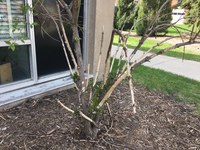Dakota Gardener: The Annual Rabbit Battle
(Click the image below to view a high-resolution image that can be downloaded)
By Joe Zeleznik, Forester
NDSU Extension
I can’t believe it’s October already. Like every year, the summer seemed to be too short. Most of the crops are harvested and even some field cultivation has happened in preparation for next spring.
The trees have done the majority of their prep work, too. The leaves have mostly changed color, and they’re well on their way to developing the deep dormancy that is so important for surviving winter.
The last few years have been tough on trees. Fall 2019 was extremely wet and that caused widespread death in ponderosa pine trees in 2020.
And that’s also when the drought began.
A warm spell in February and March of 2021 caused a lot of top dieback on birch trees. Again, this was widespread throughout the state.
And the drought worsened in 2021.
The recent rains have helped a lot. Trees were able to access that water, rehydrating themselves before winter. Keeping conifers hydrated in the fall is critical for minimizing winter injury.
Winter injury can have several causes and isn’t understood very well. Nevertheless, getting trees hydrated before winter is key in managing this issue.
The trees have done their part for winter prep. I’m working on my part.
I finally began raking leaves last week. It’s not my favorite chore. Removing and destroying leaves is very important for minimizing leaf fungal diseases next spring. The spores that fungi will spread next spring will spend this winter in fallen leaves. So as best I can, I get rid of them. I really ought to hire a teenager.
The biggest battle I have each year, though, is with the rabbits. Rabbits and voles kill more trees each winter than cold temperatures do. The animals eat the bark off younger trees – especially fruit trees – to get to the sugar-rich phloem tissue just below the bark.
If a tree loses bark all the way around its circumference, it’s as good as dead. I’ve lost several apple trees over the years, and I’ve begun to take some extreme measures.
White plastic pipes and wraps do a good job in preventing this type of damage, but only as high as the pipe goes up the stem. When there is a lot of snow, those pests climb the drifts and girdle the branches. What took years to develop can be gone in one season. It’s frustrating.
I’ve now taken to putting a wire fence around my apple trees. It’s a bit of a project to set this up, but the fence is really effective against rabbits, as long as there are no major snow drifts. If I set the fence up far enough from the tree trunk, the deer will be held back as well.
It’s an annual battle, and I’ll do my part. How will you help your trees survive the upcoming winter?
NDSU Agriculture Communication – Oct. 19, 2021
Source: Joe Zeleznik, 701-231-8143, joseph.zeleznik@ndsu.edu
Editor: Kelli Anderson, 701-231-6136, kelli.c.anderson@ndsu.edu


